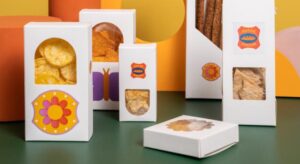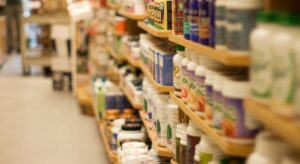
How are gluten-free products made?

Gluten is a naturally occurring protein in some grains, including rye, barley, and wheat. It serves as a binder and gives food that “stretchy” feel. Without gluten, pizza dough would not hold together and fall apart.
Those who want to avoid gluten, whether it’s because they are intolerant to this protein or have deliberately changed their dietary choices, should look for gluten-free products. This article will discuss the ingredients and techniques used to create gluten-free foods. We will also look at the source of contamination and dietary fiber in gluten-free products.
How Gluten-Free Products Should Be Made
It is crucial to understand how gluten-free foods are prepared. You might be inclined towards gluten-free products because of celiac disease or as a general life choice. While considering a gluten-free diet, you should consider these two main issues:
- Are forbidden grains being wiped out?
- Do you avoid cross-contamination?
Most of the time, gluten-free foods are cultivated, transported, stored, packed, and labeled in a gluten-free setting. At the very least, this is how they ought to be handled.
However, most naturally gluten-free items are not genuinely gluten-free because of cross-contamination during their production. Oats, for instance, are gluten-free and safe for celiacs to eat. However, on farms where they are cultivated, they are usually grown next to wheat, and thus they have wheat sown among them.
Here is how gluten-free products are adequately prepared:
They Should Be Cultivated In Isolation
Food should be cultivated separately, especially with ingredients like the oats in the previous example. They should often be developed by themselves in a controlled environment.

Handle The Ingredients Correctly
After the crop is cultivated, ingredient handling should be the next consideration. You must handle the ingredients with extreme care.
If working in a setting with gluten goods, there should be separate storage and preparation spaces that keep gluten and gluten-free items apart.
Policies also frequently require all staff to wear clean clothes and clean their hands while working.
Keep The Facility And Equipment Separated
The facilities and tools should all be kept apart.
There is a significant risk of cross-contamination from airborne particles when working in the same space as gluten-rich products. Due to this, many businesses plan to produce all gluten-free foods more than 24 hours after those containing gluten.
They also employ wet washing, which guarantees total sanitation.
Labeling Of Gluten-Free Products
Although labeling gluten-free goods are optional, all FDA-established requirements must be met by the product. However, you must follow several procedures to bear the designation “Certified Gluten Free.” These procedures include:
- Product review
- Testing
- On-site Inspection
- On-going testing
You can put your Certified Gluten Free goods into your basket, browsing for gluten-free items with confidence now that you know how they are created.
Ingredients used in gluten-free products
As the gluten-free diet movement gains momentum with the rise of celiac disease and gluten sensitivity, new ingredient innovations are emerging. Wheat flour, a staple of many gluten-containing foods, has been replaced by ingredients that have a variety of functional roles.
Pulses, ancient grains, and plant protein are three of the most popular categories of gluten-free products used in gluten-free foods. Let us explore how the innovation of these ingredients has helped create new products for gluten-free eaters.
If you’re looking for an effective gluten-free food or product, read the ingredients list carefully.
Foods that contain gluten are often made with barley, triticale, or wheat-based ingredients. The gluten-free labels on foods are made from a broader range of grains, including rye and triticale. While it’s impossible to find 100% gluten-free foods, it’s possible to find gluten-free versions of products from a reputable company.

An essential part of living with a gluten-free diet because of wheat allergy, or other food allergies and sensitivities, is finding naturally gluten-free food and altogether avoiding gluten-containing food. To make a living with a strict gluten-free diet easier, here are a few tips for choosing the best gluten-free products.
Xanthan gum – Of the most common naturally gluten-free ingredients, Xanthan gum reproduces the binding power of gluten in many foods, including baked goods and packaged foods. Xanthan gum is a fermentation product used in baking and other products. It’s also sold separately in stores. You can use it in your favorite recipes to replace the gluten in traditional flour products. If you’re looking for a gluten-free product, Xanthan gum is a great way to make your gluten-free baking products.
Glycemic acid, maltodextrin, and maltose are all common ingredients in foods made with wheat. But it would be best if you avoided corn-based glucose syrup.
Several ingredients are made using glucose syrup, including caramel and sugar alcohols. But these types of sweeteners don’t contain gluten. Gluten-free products made with wheat-derived glucose syrup are likely safe.
The FDA defines gluten-free products as containing less than 20 parts per million of protein. This is considered low by gluten-sensitive consumers. Some companies use this terminology as legal protection, while others do not. Whether the product is genuinely gluten-free depends on the manufacturer.
However, it’s essential to read the labels to determine the amount of gluten. So, how can you ensure a gluten-free product contains gluten-free ingredients?
The Technology Used To Make Gluten-Free Products.
Despite a recent rise in popularity, consumers often need help finding gluten-free products.
Historically, many gluten-free products had a gritty texture and a short shelf-life. They often contained high amounts of sugar and lacked nutritional value. Nevertheless, consumers increasingly turn to these products to improve their health and quality of life. Fortunately, technology is helping certified gluten-free manufacturers create better gluten-free products by introducing innovative ingredients and processes.
The main goal of manufacturing gluten-free products is to reduce the number of additives in the product. While conventional baking methods apply heat to the bread’s exterior, using electric shocks to heat the gluten-free product from the inside improves texture and quality. Another method is known as Ohmic heating.
A study published in the Journal of Food and Bioprocess Technology shows that this technology may be a better alternative in a gluten-free bread production process. The research indicates that the process saves energy and improves the quality of the product.
Another technique uses enzyme technology and bioprocessing to improve the nutritional values of gluten-free products. Gluten has unique properties, including the ability to preserve gas produced during fermentation. Due to this, it can be challenging to manufacture gluten-free products, so the European Union funded a project to improve the quality of gluten-free bread. Inulin-type fructans are a type of fructan that improves gas retention capacity and increases the hydration ratio.
With technological advances, food manufacturers have created more innovative products that cater to a wider consumer base. While many traditional baking and processing methods still contain gluten, many innovations help create more delicious and nutritious products for consumers. Gluten-free bread, cookies, and cakes can now be a staple in everyday life.
A new crop of plant-based ingredients is helping make gluten-free recipes even more desirable. While these advances in gluten-free food formulation are certainly making our lives easier, there are more challenges to overcome.
Sourdough has improved the technological and nutritional properties of gluten-free baked goods. It helps reduce the risk of mold spoilage and prolongs the shelf-life of the products. It also increases nutritional value by making minerals and vitamins available. Furthermore, it produces exopolysaccharides, which act as a hydrocolloid. This production makes gluten-free baked goods more nutritious and better for our bodies.
Sources Of Contamination In Gluten-Free Products
There are many sources of gluten contamination in products and even some dietary supplements labeled gluten-free. However, the study of two groups of food products found that some contain gluten at levels higher than 20 ppm. Researchers used the analysis based on Kruskal-Wallis one-way ANOVA, Fisher’s test, and multiple comparisons to identify the sources of contamination. The researchers also compared the prices, the proportion of gluten in each product, and the gluten content.
Another common source of contamination in gluten-free flours and products is cross-contamination. Cross-contamination occurs when food comes in contact with gluten-containing ingredients or gluten-containing food. Other sources of contamination of gluten-free products include soy, miso, and sprouted bread.
Even some gluten-free products made with corn or rice contain gluten. Also, check the ingredients label of any prescription or over-the-counter drugs before taking them.
Cosmetics can also contain gluten. It can affect your health, but most companies do not list all ingredients. So, it’s impossible to avoid gluten-containing products, but there are ways to prevent cross-contamination and avoid causing harm to your body.
Cosmetics can also contain gluten. It can affect your health, but most companies do not list all ingredients. So, it’s impossible to avoid gluten-containing products, but there are ways to avoid cross-contamination and avoid causing harm to your body.
The most common source of contamination of gluten-free foods is wheat. The average gluten content in a product should be no more than 20 ppm. However, it’s important to remember that the contamination level can vary from product to product. For example, a product may contain up to 20 ppm of wheat, while a gluten-free product must have less than 20 ppm. Wash the oat thoroughly if you’re buying lentils in an unlabeled package.

Since traces of gluten can be traced in food matrices, special precautions need to be taken when handling and preparing products for those with coeliac disease. An essential step in preventing cross-contamination is to clean all surfaces before beginning work thoroughly. Wooden utensils are more challenging to clean than metal or glass ones. Use separate utensils, jars, and bread baskets for gluten-free foods.
Sources Of Dietary Fiber In Gluten-Free Products
One source of dietary fiber in gluten-free products is brown rice. While rice is rich in fiber, experts do not recommend it as a primary source. Rice contains varying amounts of inorganic arsenic, a known carcinogen, and most gluten-free products have rice flour. That means gluten-free people are already exposed to higher levels of arsenic than those who follow the standard Western diet.

The recommended daily allowance for fiber is around 30 grams per day for adults. Children and adolescents should consume between 15g and 20g of fiber a day. However, few people in developed countries consume enough fiber to meet this recommendation. A typical banana provides approximately 2.5g of dietary fiber, and a slice of wholemeal bread contains almost four grams of dietary fiber. For those worried about gluten sensitivity, gluten-free bread made with wholemeal flour should be a good choice.
Fiber supports a healthy gut microbiome responsible for making vitamins and protecting the body from foodborne illness. In addition to aiding digestion, fiber reduces belly bloat and can help maintain a healthy weight. Fiber also boosts the immune system and reduces the risk of heart disease, diabetes, and obesity. It can help lower cholesterol levels.
Beans are the most popular source of dietary fiber for wheat-free individuals. A cup of cooked beans provides about two grams of fiber, and half a cup of teff and quinoa is around three grams. Other good sources of dietary fiber include whole-grain foods and seeds. And if you’re in the mood for something sweet, why not try edamame or some other delicious snack?

Looking To Create Gluten-Free Food?
Those on a gluten-free diet, or anyone with complicated food allergies, can trust that products manufactured in A Taylor Gleason Enterprise location are safe to consume. Get in touch with TGE to learn more about how you can package gluten-free food products safely in our allergen-free facilities.

Conclusion
Even if you do not have gluten intolerance, you must have heard of discussion over the health advantages and disadvantages of eating gluten-free foods. A gluten-free diet is a medical necessity for people with celiac disease ( a type of autoimmune disorder ) or gluten intolerance.
The main course of treatment for celiac disease is a gluten-free diet. Many people who don’t have this illness likewise avoid gluten because of its alleged health advantages.
Celiac disease sufferers’ immune systems attack and harm the wall of their small intestine when they consume gluten. The body’s capacity to absorb nutrients into the bloodstream decreases with repeated gluten consumption. Almost every item is made from gluten-containing grains, including cereal, bread, snacks, drinks, and even sauces like teriyaki sauce. Such products can make it challenging to eliminate gluten-rich food, but it will be worthwhile to put in the effort.
Gluten-free versions of the same products are also however available. Moreover, there are products available in the market, like gluten-free pasta, certified gluten-free oats, alcoholic beverages, etc., that you can consume.
Knowing how to make gluten-free food, what ingredients are used, what technology is used to make these products, and how these products are cross-contaminated. Lastly, knowing the sources of dietary fibers in these products can be extremely useful.




